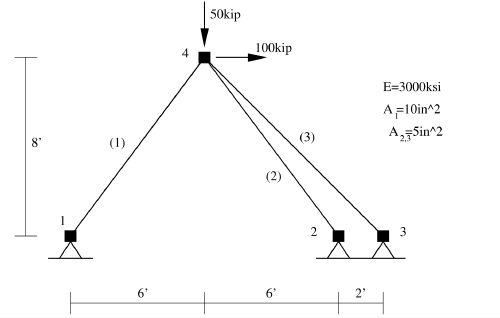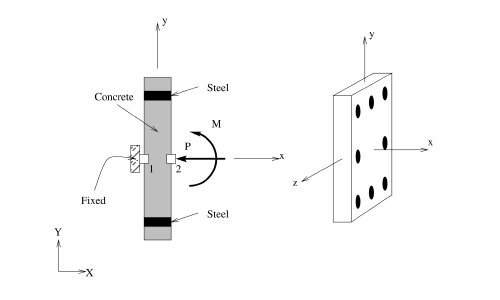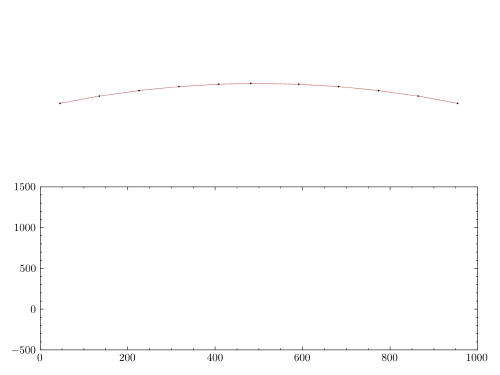Elastic Response Spectra
April 2020, By Amir Hossein Namadchi
This one deals with an elastic SDOF system subjected to the El Centro ground acceleration, $\ddot{d_g}$. The aim is to obtain response spectra for the system with various damping values.
This notebook is adapted from https://github.com/AmirHosseinNamadchi/OpenSeesPy-Examples/blob/master/Elastic%20Response%20Spectra.ipynb

import numpy as np
import opensees.openseespy as ops
import matplotlib.pyplot as plt
# Loading El Centro EQ data (North-south component)
el_centro_raw = np.loadtxt('elCentro.txt')
plt.figure(figsize=(15,3))
plt.plot(el_centro_raw[:,0], el_centro_raw[:,1], color='k')
plt.ylabel('$\ddot{d_g} (g)$', {'size':14})
plt.xlabel('Time (sec)', {'size':13})
plt.grid()
plt.yticks(fontsize = 14)
plt.xticks(fontsize = 14)
plt.xlim([0.0, el_centro_raw[-1,0]]);
Output:
<Figure size 1500x300 with 1 Axes>
Analysis
# Define a period range below
T_min = 0.00001
T_max = 5
dT = 0.05
# a list of damping ratios to be included
zeta_list = np.array([0.02, 0.03, 0.05])
# Base units
cm = 1.0
sec = 1.0
# Gravitational constant
g = 981*cm/sec**2
The analyze_SDOF function performs numerical time integration of a damped elastic SDOF system subjected to the previously defined base excitation. Then, it returns the absolute maximum of response parameters as a dict. It should be reminded that, for a given ground motion, the response parameters of the SDOF system depends only on the natural period and its damping ratio, i.e. $T$ and $\zeta$.
def analyze_SDOF(period, damping_ratio):
# natural frequency
omega = (2*np.pi)/period
# stiffness
k = omega**2
# Damping
c = 2*damping_ratio*omega
# Model Definition
ops.wipe()
ops.model('basic', '-ndm', 1, '-ndf', 1)
ops.node(1, 0.0)
ops.node(2, 0.0)
ops.uniaxialMaterial('Elastic', 1, k)
ops.element('zeroLength', 1, *[1, 2], '-mat', 1, '-dir', 1)
# unit mass is assumed
ops.mass(2, 1.0)
ops.rayleigh(c, 0, 0, 0)
ops.fix(1, 1)
## Loading
dt = 0.02
ops.timeSeries('Path', 1,
dt=dt,
values=el_centro_raw[:,1]*g,
time=el_centro_raw[:,0])
ops.pattern('UniformExcitation', 1, 1, '-accel', 1)
## Analysis
ops.constraints('Transformation')
ops.numberer('Plain')
ops.system('ProfileSPD')
ops.algorithm('Linear', False, False, True)
ops.integrator('Newmark', 0.5, 0.25)
ops.analysis('Transient')
results = {'D':[],'V':[], 'A':[]}
for i in range(len(el_centro_raw)):
ops.analyze(1, dt)
results['D'].append(ops.nodeDisp(2, 1))
results['V'].append(ops.nodeVel(2, 1))
results['A'].append(ops.nodeAccel(2, 1))
return {'SD': np.max(np.abs(results['D'])),
'SV': np.max(np.abs(results['V'])),
'SA': np.max(np.abs(results['A']))}
Here, I use nested loops to analyse the system for various damping ratios and periods.
data_frame = dict()
for z in zeta_list:
# re-initialization
resp = {'T':[0],'SD':[0], 'SV':[0], 'SA':[0]}
for T in np.arange(T_min, T_max, dT):
SR = analyze_SDOF(T, z)
resp['SD'].append(SR['SD'])
resp['SV'].append(SR['SV'])
resp['SA'].append(SR['SA'])
resp['T'].append(T)
# Appending keys and values dynamically
data_frame[z] = resp
print('Done with zeta=', z,'!')
Output:
Done with zeta= 0.02 !
Done with zeta= 0.03 !
Done with zeta= 0.05 !
Visualization
# Displacment -----------
plt.figure(figsize=(14,5))
for z in zeta_list:
plt.plot(data_frame[z]['T'], data_frame[z]['SD'],
label=('$\zeta$ = '+str(z)))
plt.ylabel('Displacement (cm)', {'size':14})
plt.xlabel('Period (sec)', {'size':14})
plt.legend()
plt.grid()
plt.yticks(fontsize = 14)
plt.xticks(fontsize = 14)
plt.title('Displacement Response Spectrum',
{'size':18});
# Velocity ------------
plt.figure(figsize=(14,5))
for z in zeta_list:
plt.plot(data_frame[z]['T'], data_frame[z]['SV'],
label=('$\zeta$ = '+str(z)))
plt.ylabel('Velocity (cm/sec)', {'size':14})
plt.xlabel('Period (sec)', {'size':14})
plt.legend()
plt.grid()
plt.yticks(fontsize = 14)
plt.xticks(fontsize = 14)
plt.title('Veloctiy Response Spectrum', {'size':18});
# Acceleration ------------
plt.figure(figsize=(14,5))
for z in zeta_list:
plt.plot(data_frame[z]['T'], np.array(data_frame[z]['SA'])/g,
label=('$\zeta$ = '+str(z)))
plt.ylabel('Acceleration (g)', {'size':14})
plt.xlabel('Period (sec)', {'size':14})
plt.legend()
plt.grid()
plt.yticks(fontsize = 14)
plt.xticks(fontsize = 14)
plt.title('Acceleration Response Spectrum',
{'size':18});
Output:
<Figure size 1400x500 with 1 Axes>
<Figure size 1400x500 with 1 Axes>
<Figure size 1400x500 with 1 Axes>
References
-
Chopra, A.K., 2017. Dynamics of structures. theory and applications to. Earthquake Engineering.


